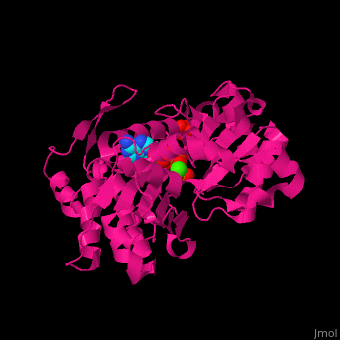Function
Actin is a protein found in all eukaryotic cells.[1] It is the monomer of two types of filaments: microfilaments which are part of the cytoskeleton and thin filaments which are part of muscles. Three isoforms of actin are identified: α (Aa) (or G-actin) found in muscle tissue, β (Ab) and γ (Ag) actins are components of the cytoskeleton. F-actin is Aa bound to ATP. For more details see:
*F-actin
*Non-polymerizable monomeric actin.
(PDB entries 1hlu and 2btf; morph was taken from Gallery of Morphs of the Yale Morph Server). Actin participates in muscle contraction, cell motility, cell division and cytokinesis. Actin associated with myosin is responsible for most cell movements.
- α actin is found exclusively in muscle fibres.
- β actin is required for early embryonic development[2].
- γ actin is required for cytoskeletal maintenance[3].
See also Actin Protein (Hebrew)
Disease
Mutations in α-actin found in skeletal striated muscles can cause myopathy. Mutations in α-actin found in smooth muscles can cause thoracic aortic aneurism. Mutations in α-actin found in heart muscles can cause heart malfunctioning.
Structural highlights
in a cleft. Water molecules are shown as red spheres. . .[4] It changes its conformation upon hydrolysis of its bound ATP to ADP. Actin filaments are polar. They are formed with all monomers having their clefts pointing in the same direction.
3D Structures of Actin
Actin 3D structures

